Composition
by Michael Frye | Nov 6, 2016 | Composition, Vision and Creativity
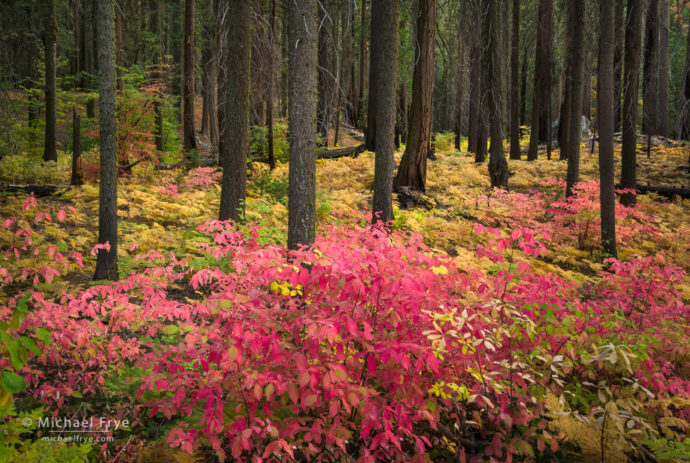
Autumn forest with dogwoods and ferns, Yosemite, October 13th. I stood on a log to see over the foreground dogwoods and into the forest; the focal length was 35mm.
I’ve made many images of intimate landscapes over the years, and the vast majority of them were taken with a telephoto lens (usually my 70-200mm zoom). It makes sense to use a lens with a narrower angle of view when focusing on a small piece of the landscape and trying to eliminate clutter in complex forest scenes. Telephoto lenses are also great for compressing space and emphasizing patterns – typically key components of intimate landscapes.
But lately I’ve found myself using wide-angle lenses more and more for smaller scenes. Part of the impetus for this was just buying a new lens. This past July I purchased a new wide-angle zoom (the Sony Vario-Tessar FE 16-35mm f/4 ZA OSS), and it’s natural to want to use and test a new piece of equipment, so I started pulling this lens out in many situations just to see what it could do. But another part of the impetus was just the desire to do something different. I’ve had plenty of practice composing intimate landscapes with telephoto lenses, and I wanted to force myself to look at these scenes in a new way.
(more…)
by Michael Frye | Oct 6, 2016 | Composition, Light and Weather
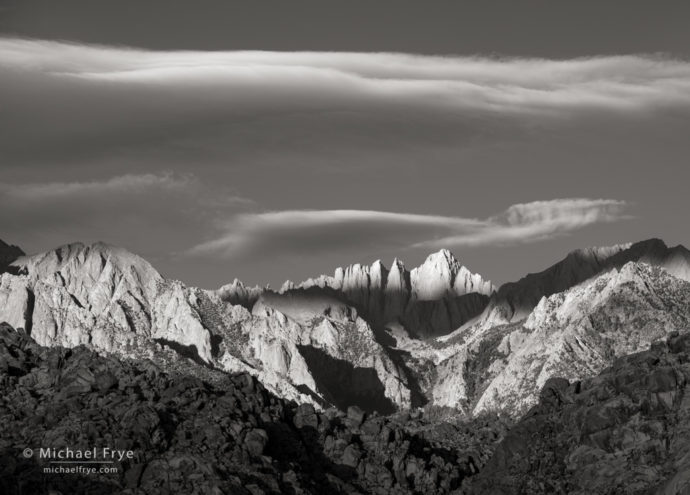
Sunrise on Mt. Whitney from the Alabama Hills, CA, USA
On our trip to the eastern Sierra last week Claudia and I made a detour down to the Alabama Hills. This area is a bit further from home than our usual eastside haunts, so we don’t go there often, and I sometimes forget how amazing it is. The jumbled rocks of the Alabama Hills are interesting and photogenic in their own right, but combined with the abrupt escarpment of the mountains to the west… well it’s just spectacular.
(more…)
by Michael Frye | Sep 22, 2016 | Composition
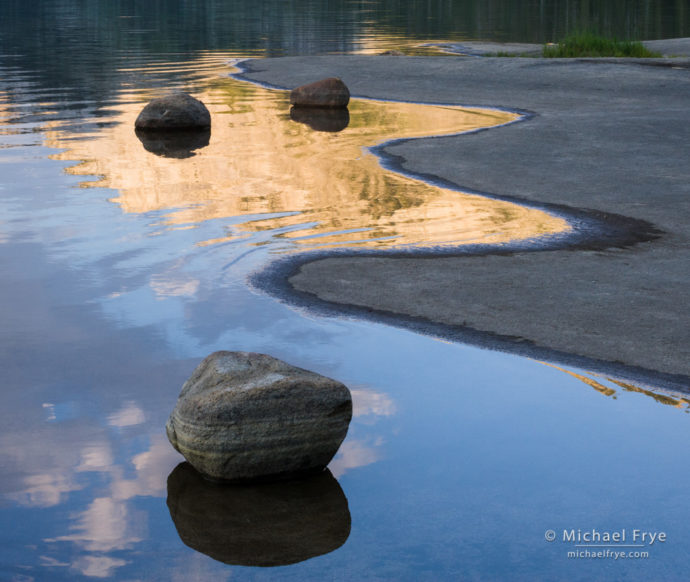
Rocks and reflections along the shore of Tenaya Lake, Yosemite. This image features both curves and circles.
I really like curved lines. I was reminded of this last weekend when my friend Mike Osborne showed me some of his junkyard abstracts on his iPad. All the photographs were wonderful and imaginative, but the ones I liked best often had curves. And many of my own favorite photographs have curves too. Curves look organic, and sensuous, and add a certain visual flow to a photograph that’s hard to generate without them.
(more…)
by Michael Frye | Aug 21, 2016 | Composition, Vision and Creativity
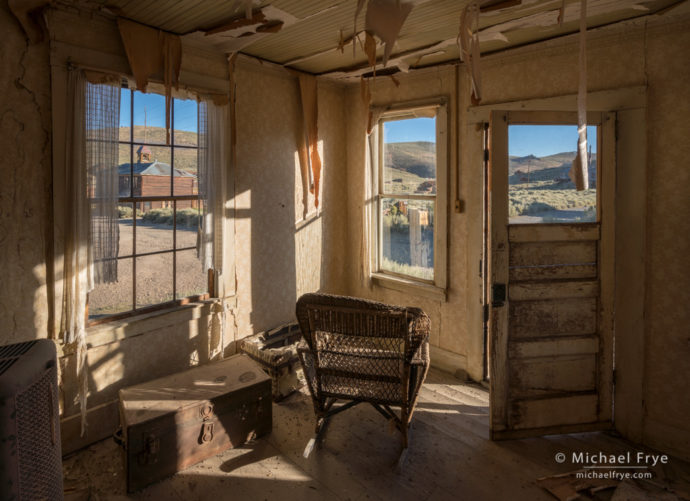
McMillan House interior, Bodie State Historic Park, California. The high contrast of this scene required using Lightroom’s HDR Merge. Also, I deliberately avoided having sunlit areas touch the borders of the image. A bright spot along the edge would pull the viewer’s eye out of the photograph.
As I’ve explored this place, I’ve realized that I’m not as interested in the abandoned mining equipment and machinery, as fascinating as some of those things are. I’m drawn more to the places where people once ate and slept and drank and socialized, and left behind the artifacts of their lives – furniture, cooking utensils, books, magazines, pictures, cans, bottles, a baby carriage, a bird cage, sewing machines, coats, pants, hats, shoes…
(more…)
by Michael Frye | Jul 31, 2016 | Composition
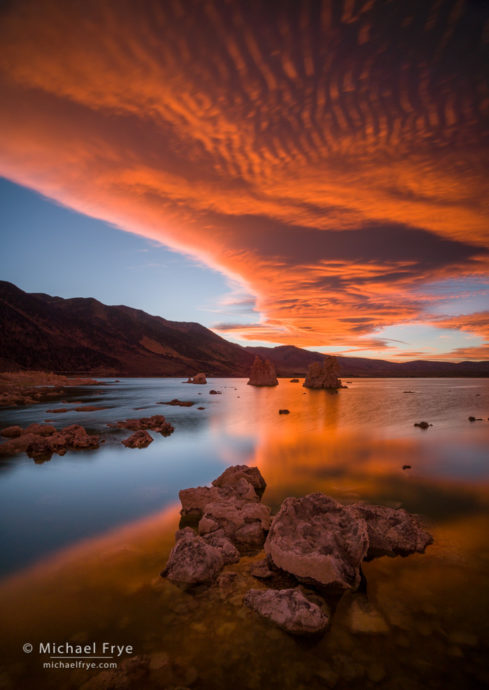
Fiery sunset over Mono Lake, CA, USA
Many books and articles about landscape photography advocate using a wide-angle lens and a low camera position. Certainly wide-angle lenses have their place in landscape photography (though they are not, by any means, the only choice). And getting a wide-angle lens low to the ground and close to some foreground objects can create an exaggerated near-far perspective that gives the photograph a sense of depth.
But a low camera position can also foreshorten the foreground and middle-ground, scrunching them together and merging objects that could and should be separated visually. A higher camera position can often create better separation and spacing between foreground and middle-ground objects, and a better flow to the composition.
Two photographs from Mono Lake might help show what I’m talking about. I made these earlier this summer when some clouds appeared out of nowhere in the middle of a stretch of clear, dry, cloudless weather. In the first of these images (above) there was a spectacular sunset going on above the lake. I might have preferred to have just water and reflections in the foreground, with no rocks, but that wasn’t an option: there were too many rocks, and no way to keep all of them out of the frame if I wanted any water at all in the picture. So I had to work with the rocks, and find a way to incorporate them into the composition.
(more…)
by Michael Frye | Jun 23, 2016 | Composition
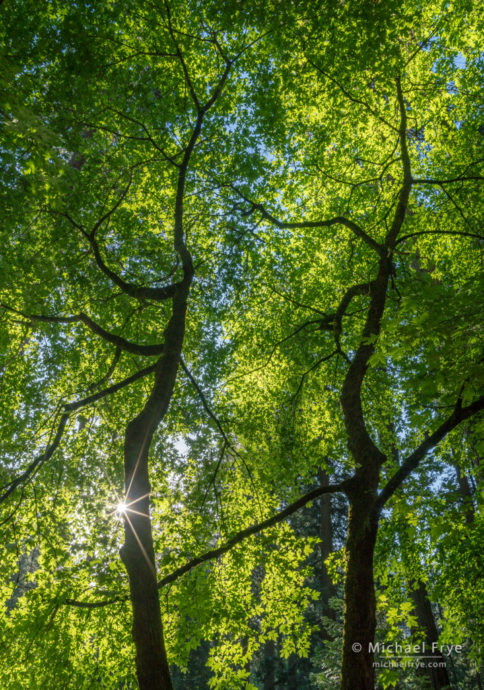
Big-leaf maples in spring, Yosemite NP, CA, USA
A couple of weeks ago Claudia and I were in Yosemite Valley and drove past this maple with beautiful, backlit, bright-green leaves. So we stopped to see if there might be a photograph there. At first I couldn’t find a composition. Although the glowing leaves were beautiful, the light was splotchy, and this tree was right above a tent cabin in Housekeeping Camp, so it was difficult to keep that tent and others out of the picture.
But it seemed like there was something there, so we persisted, me with my big camera, Claudia with her iPhone. The visual clutter caused by the splotchy light, random arrangements of branches, and distracting background objects (the tent cabins) initially seemed to warrant using a telephoto lens, and focusing on a section of the leaves. The longer lens would help simplify things, keep the clutter to a minimum, and focus attention on the leaves themselves, which were what originally caught my eye. But I couldn’t find a group of leaves that had a strong enough pattern, and the photographs didn’t convey the feeling of those glowing leaves.
(more…)














